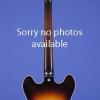Les Paul Artist with Moog Active Circuitry -- "A Flick of a Switch Away from Total Disaster"
This 12 3/4-inch-wide guitar weighs 10.20 lbs. and has a nice, fat nut width of just under 1 11/16 inches and a standard Gibson scale length of 24 3/4 inches. Solid mahogany body with "scarfed" cutaway back, carved mahogany top, mahogany neck, and single-bound ebony fretboard with 22 jumbo frets and inlaid pearl block position markers. Brass nut. Headstock with inlaid pearl "Gibson" logo and script "LP" inlay. Two-layer (black/white) plastic truss-rod cover. Individual Gibson (Grover) Roto-Matic tuners with tulip-shaped metal buttons. Serial number ("81500567") stamped on the back of the headstock. Multi-ply binding on the top of the body and the headstock. Two Gibson humbucking pickups with outputs of 19.00k and 19.10k. Three-layer (black/white/black) plastic pickguard. Moog active circuitry. Three controls (volume, bass, and treble) and three mini-toggle switches (for compression, expansion, and brightness) on the lower treble bout, plus three-way pickup selector switch on the upper bass bout. Black plastic barrel-shaped "Speed" knobs with white markings. Nashville bridge and TP-6 fine-tuning tailpiece. Gold-plated jack plate cover. All hardware gold-plated. This guitar is in exceptionally fine condition, with only minor belt-buckle wear on back, one small mark on the back of the neck, and a few tiny marks on the body. Housed in the original Gibson black hardshell case with black plush lining (8.75).
"One of the most interesting and short-lived Les Paul models in Gibson's Norlin era was the Les Paul Artist model (sometimes also referred to as the 'Les Paul Active'). The prototypes of the Les Paul Artist were developed in 1978, which used a circuit of active electronics originally developed for Gibson's RD Artist model. In the late 70's, synthesizers were the rage, and Norlin surmised that a relationship with the famous synthesizer manufacturer, Moog, would aid Gibson at gaining market share for its guitars. MOOG synthesizers were manufactured and marketed by Norlin Industries Inc. beginning in approximately 1977...The Gibson RD line (RD Artist) was launched in 1977, but did not turn out to be successful. Gibson believed that the radical styling of the RD Artist was to blame, and moved to combine the RD technology with traditional designs like the ES models and the Les Paul models. The Les Paul Artist actually has two circuit boards which are installed under a large control plate on the back of the Les Paul Artist model...There is also a separate control plate for the 9 volt battery placement. Because of the size of the circuit boards, a large amount of wood had to be removed from the back of the Les Paul. Despite this removal of wood, the Les Paul Artists are heavy guitars...The Les Paul Artist is a handsome guitar with some very unique features besides the Moog circuit board and active electronics. All Artists were made in Nashville. The Artist has a unique peghead logo with the letters 'LP' in script style, a gold truss rod cover with the 'Les Paul Artist' inscription, brass nut, TP-6 fine tuning tailpiece, gold hardware, two potted gold plated Gibson Humbucking pickups, five piece laminated maple neck with volute, a bass, treble, and one master volume pot, brass nut, new design 'scarfed' cutaway back, black speed knobs, gold jack plate, Nashville bridge, block fingerboard inlays, multi-ply binding on the top of the body, neck, and peghead, and three mini-toggle switches for compression, expansion, and brightness. The tone controls are active, with a notch in the midway ('0') position. With the tone controls at this mid-point, the sound of the Artist is close to a traditional Les Paul tone. The tone controls below this mid position (selections numbered 1-5) or above mid position (also numbered 1-5) actively 'cut' or 'boost' the tone, respectively. The active circuitry is enabled (and battery drain occurs) when a cord is plugged into the guitar's phone jack. Colors for the Artist were Antique Fireburst, Antique Sunburst, or Ebony finish...The craftsmanship of the Artist model was outstanding, with excellent fit, finish, and attention to detail. The Artist is a unique sounding guitar, with many tonal variations. With the tone controls in the 'boost' position, the guitar takes on a unique tone that seems suited for jazz or chord work with shimmering arpeggios. It can be shaped to sound very 'Fender-esque' or very dark and woody with the adjustment of the tone controls and switches. The compression feature greatly increases the volume of the guitar in addition to working like a normal outboard compressor. The neck is of medium thickness and is very comfortable to play. The guitar is slightly neck heavy in design due to the removal of wood for the active electronics and the Custom-style (large) peghead. The 1980 Gibson price list indicates a list price of $1,299.00 for the Artist, with an additional $119.50 for an optional Protector case. In contrast, the list prices for a Les Paul Artisan and Les Paul Custom were $1,099.00 and $949.00 respectively. It is ironic that the complexity and wide sonic variety of the Artist led to its demise...Tim Shaw of Gibson said the he didn't appreciate until later that '…guitar players are really conservative folks, and nobody really wanted a Les Paul that did all that.' Tim was also quoted as saying that 'somebody once said that with one of those Artists you were a flick of a switch away from total disaster.' Thus, the Artist, which was introduced in late 1979, was dropped by 1982 from the Gibson line" (Mike Slubowski, "Gibson Les Paul Artist Model: No Moog for Guitarists?" at http://www.lespaulforum.com/slubarticle/artist/artist12.02.html).
Translate:

